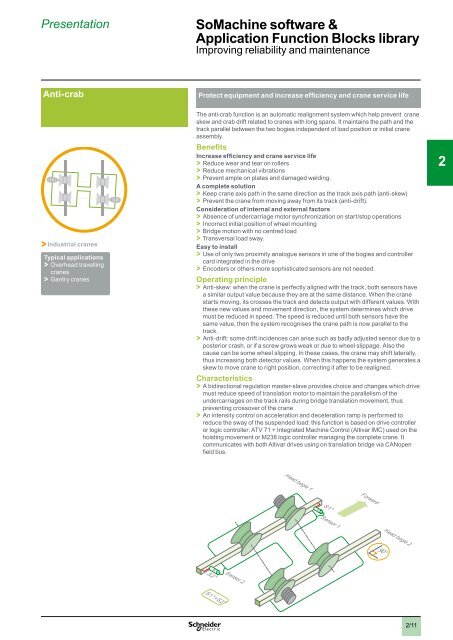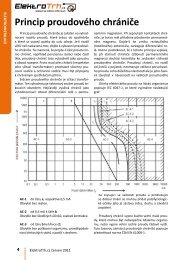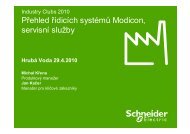2 - Schneider Electric CZ, s.r.o.
2 - Schneider Electric CZ, s.r.o.
2 - Schneider Electric CZ, s.r.o.
Create successful ePaper yourself
Turn your PDF publications into a flip-book with our unique Google optimized e-Paper software.
Presentation<br />
SoMachine software &<br />
Application Function Blocks library<br />
Improving reliability and maintenance<br />
Anti-crab<br />
> > Industrial cranes<br />
Typical applications<br />
> > Overhead travelling<br />
cranes<br />
> > Gantry cranes<br />
Protect equipment and increase efficiency and crane service life<br />
The anti-crab function is an automatic realignment system which help prevent crane<br />
skew and crab drift related to cranes with long spans. It maintains the path and the<br />
track parallel between the two bogies independent of load position or initial crane<br />
assembly.<br />
Benefits<br />
Increase efficiency and crane service life<br />
> > Reduce wear and tear on rollers<br />
Reduce mechanical vibrations<br />
> > Prevent ample on plates and damaged welding.<br />
A complete solution<br />
> > Keep crane axis path in the same direction as the track axis path (anti-skew)<br />
> > Prevent the crane from moving away from its track (anti-drift).<br />
Consideration of internal and external factors<br />
Absence of undercarriage motor synchronization on start/stop operations<br />
> > Incorrect initial position of wheel mounting<br />
> > Bridge motion with no centred load<br />
> > Transversal load sway.<br />
Easy to install<br />
> > Use of only two proximity analogue sensors in one of the bogies and controller<br />
card integrated in the drive<br />
> > Encoders or others more sophisticated sensors are not needed.<br />
Operating principle<br />
> > Anti-skew: when the crane is perfectly aligned with the track, both sensors have<br />
a similar output value because they are at the same distance. When the crane<br />
starts moving, its crosses the track and detects output with different values. With<br />
these new values and movement direction, the system determines which drive<br />
must be reduced in speed. The speed is reduced until both sensors have the<br />
same value, then the system recognises the crane path is now parallel to the<br />
track.<br />
> > Anti-drift: some drift incidences can arise such as badly adjusted sensor due to a<br />
posterior crash, or if a screw grows weak or due to wheel slippage. Also the<br />
cause can be some wheel slipping. In these cases, the crane may shift laterally,<br />
thus increasing both detector values. When this happens the system generates a<br />
skew to move crane to right position, correcting it after to be realigned.<br />
Characteristics<br />
> > A bidirectional regulation master-slave provides choice and changes which drive<br />
must reduce speed of translation motor to maintain the parallelism of the<br />
undercarriages on the track rails during bridge translation movement, thus<br />
preventing crossover of the crane<br />
> > An intensity control on acceleration and deceleration ramp is performed to<br />
reduce the sway of the suspended load: this function is based on drive controller<br />
or logic controller: ATV 71 + Integrated Machine Control (Altivar IMC) used on the<br />
hoisting movement or M238 logic controller managing the complete crane. It<br />
communicates with both Altivar drives using on translation bridge via CANopen<br />
field bus.<br />
1<br />
2<br />
3<br />
4<br />
5<br />
6<br />
7<br />
8<br />
9<br />
10<br />
2/11
















